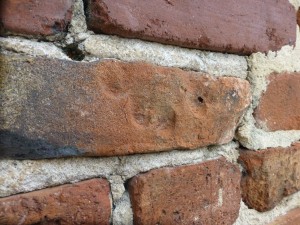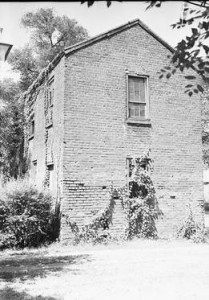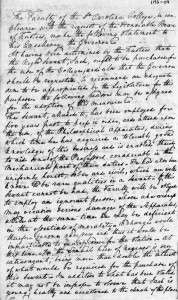Revealing slavery’s legacy at a public university in the South (Part 2)
24 October 2014 – Evan Kutzler, Sarah Conlon, Jamie Diane Wilson, and JoAnn Zeise
graduate students, The Public Historian, slavery, digital media, projects, digital history, memory, sense of place, human rights, politics, race

This handprint on one of the bricks of the wall surrounding the old campus was very likely made by a slave. Photo credit: Slavery at South Carolina College team.
Continued from Part 1.
As well as trying to convey a sense of these enslaved workers as people, the team of graduate students working on the “Slavery at South Carolina College” website also sought to connect this history to the physical landscape. Harnessing the power of place to tell the story of slavery, we emphasized the built environment of the historic college. The antebellum section of the campus, referred to today as the Horseshoe because of its shape, survives as the historic heart of the modern university. But the most important reason to emphasize the built environment is that slaves physically constructed it. Enslaved people made the bricks that composed these structures at the local brick works. Draymen must have carted construction materials to the college, and contractors who utilized enslaved labor oversaw construction, including the masonry and indoor woodwork. In the wall surrounding the campus, we discovered a brick with the literal hand print of its maker, almost certainly that of a slave.

This slave dwelling still stands behind the current President’s house at the University of South Carolina. Photo credit: South Caroliniana Library, University of South Carolina
The physical space of the Horseshoe proved to be a rich resource for this project. One especially significant building remains on the campus–a two-story brick kitchen house and slave quarters. Slaves resided in other buildings as well. Our reading of the Minutes of the Board of Trustees from 1833 yielded information about the use of the cellar of the President’s House for this purpose, as well as kitchens behind other faculty duplexes built by the college. Enslaved people also cooked and cleaned for white students and faculty within these spaces.
At first glance, these buildings provide a monument simply to the wealthy and politically prominent elite of antebellum South Carolina, but they are also a testimony to the labor of the African Americans who constructed and maintained them and on whom South Carolina College depended to function as an institution of higher learning. We hoped to utilize their visibility and the power of place to tell a story they were never intended to tell.
Geographic Information Systems (GIS) served as an effective tool to display the nineteenth-century and twenty-first-century landscapes. GIS enables the use of multiple layers of data on a single map. In this case, our data consisted of an 1884 Sanborn Fire Insurance Map and a map of the modern campus. The Sanborn map reveals the locations of numerous outbuildings, including five two-story kitchens that doubled as slave quarters. Although the nineteenth-century map is quite accurate, it is not on a modern coordinate system. It was possible to overlay the maps though a process known as geo-rectification. While the front faces and landscapes of the main college buildings still have a strong resemblance to the antebellum landscape, GIS helped us imagine the altered space behind the older structures as well.

This c.1816 letter details South Carolina’s purchase of a “Negro servant, Jack,” to assist in the school laboratory. Photo credit: South Carolina Department of Archives & History
Along with telling individual and place-based stories, another aim for the website was to show the centrality of slavery to students, professors, and the intellectual life of the college. While researching the legacy of the buildings, we discovered additional information about slaves and slavery on the campus through documents and books about the white college presidents, professors, and alumni, many of whom made these buildings their homes. The brief biographies included on the website emphasize how they lived with and discussed slavery, and, if known, the names of their slaves.
We considered the possibility that including white men on the website would undermine our primary goal of foregrounding the slaves themselves, but we concluded that the lives of the white faculty and students are an integral part of the story of slavery at the college. Not only did the faculty provide an open and clear example of slave ownership on campus, but their lives also prove significant because these influential men taught generations of students what to think about slavery. Alumni took their training from South Carolina College out into the state, the region, and the world. [2]
Our decision to incorporate students into the website narrative reflected the same reasoning as the decision to include the college faculty. Students affected the slaves’ daily experiences on campus. These young men observed and conversed with the slaves who worked and lived around them. The scanty records of interactions between the two groups also reveal that students sometimes abused slaves and received faculty reprimands.
Students also contributed to slavery ideology as they argued pertinent questions of the day, such as emancipation or slave literacy, in debating societies. As adults, at least 24 former students signed the 1860-61 South Carolina Ordinance of Secession to protect the slave society. These men included Andrew Gordon Magrath, a federal judge who ruled in 1860 that the African slave trade was not piracy; prominent fire-eater and antebellum governor John Hugh Means; and Christopher Gustavus Memminger, secessionist and Confederate Secretary of the Treasury.
The extent to which slavery at South Carolina College influenced the actions of alumni is uncertain. The point remains, however, that these men lived in a slave society not only as children and in their professional lives but also as they learned to be leading citizens. Through examining the records concerning slaves as well as the antebellum buildings and the lives of college faculty and students, we strove to present a multifaceted picture of slave life at South Carolina College.
Part 3 follows.
~ Evan Kutzler is a PhD candidate in history and an alumnus of the Public History Program at the University of South Carolina. He writes on nineteenth-century America, public history, and, especially, the history of the senses.
~ JoAnn Zeise is an alumna of the Public History Program at the University of South Carolina. She received her MA in the summer of 2012. She is currently the Curator of History at the South Carolina State Museum. Her research interests include the cultural history and material culture of South Carolina.
~ Sarah Conlon is an alumna of the Public History program at the University of South Carolina. Her research interests are gender and healthcare in the US South. She received her MA in the summer 2012. She is currently the Collections Manager at the Battleship TEXAS State Historic Site in La Porte, Texas.
~ Jamie Diane Wilson is a PhD candidate in U.S. History and Instructor in US History to 1865 at the University of South Carolina. Her research interests include Antebellum Southern intellectual history and public history.
[1] Treasurer’s Records, Box 1, University Archives, South Caroliniana Library, Columbia, South Carolina; Dumas Malone, The Public Life of Thomas Cooper (Columbia: University of South Carolina Press, 1961), 20-21, 284; Francis Lieber, The Life and Letters of Francis Lieber (Boston: J.R. Osgood, 1882), 109; James Oscar Farmer, The Metaphysical Controversy: James Thornwell and the Synthesis of Southern Values (Macon, GA: Mercer University Press, 1986), 229.
[2] Several documents and works discuss the antebellum faculty’s widespread influence. Significant examples include professors and presidents Thomas Cooper and James Henley Thornwell, who trained their students in pro-slavery argument, figured in pro-slavery state politics, owned slaves, and interacted with campus-owned slaves. Their personal papers are held by the South Caroliniana Library, University of South Carolina. For additional information, see Dumas Malone, The Public Life of Thomas Cooper (Columbia: University of South Carolina Press, 1961), and Benjamin Palmer, ed., The Life and Letters of James Henley Thornwell (Whittet and Shepperson, 1875). Particularly important alumni include James Marion Sims and Hugh Swinton Legaré; see Sims, The Story of My Life (1884; reprint NY: DaCapo, 1968), and Michael O’Brien, A Character of Hugh Legaré (Knoxville, TN: University of Tennessee Press, 1985.)




1 comment